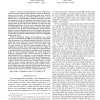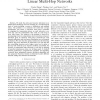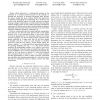101
Voted
INFOCOM
2008
IEEE
15 years 7 months ago
2008
IEEE
—Knowledge of the network path properties such as latency, hop count, loss and bandwidth is key to the performance of overlay networks, grids and p2p applications. Network operat...
123
click to vote
INFOCOM
2008
IEEE
15 years 7 months ago
2008
IEEE
— Load factor based congestion control schemes have shown to enhance network performance, in terms of utilization, packet loss and delay. In these schemes, using more accurate re...
114
click to vote
INFOCOM
2008
IEEE
15 years 7 months ago
2008
IEEE
—We develop a practical and comprehensive hybrid rogue access point (AP) detection framework for commodity WiFi networks. It is the first scheme that combines the distributed wi...
109
click to vote
INFOCOM
2008
IEEE
15 years 7 months ago
2008
IEEE
— While the concept of collaboration provides a natural defense against massive spam emails directed at large numbers of recipients, designing effective collaborative anti-spam s...
110
click to vote
INFOCOM
2008
IEEE
15 years 7 months ago
2008
IEEE
Abstract—We present a framework for designing delayindependent end-to-end congestion control algorithms, where each end-user may have a different utility function. We only requir...
120
click to vote
INFOCOM
2008
IEEE
15 years 7 months ago
2008
IEEE
—Cooperative relaying has been shown to provide diversity gains which can significantly improve the Packet Error Rate (PER) in wireless transmissions. In ad hoc wireless routing...
134
click to vote
INFOCOM
2008
IEEE
15 years 7 months ago
2008
IEEE
— We study the end-to-end resource allocation in an OFDM based multi-hop network consisting of a one-dimensional chain of nodes including a source, a destination, and multiple re...
141
click to vote
INFOCOM
2008
IEEE
15 years 7 months ago
2008
IEEE
Abstract—Content-based routing (CBR) is becoming increasingly popular as a building block for distributed applications. CBR differs from classical routing paradigms as messages a...
117
click to vote
INFOCOM
2008
IEEE
15 years 7 months ago
2008
IEEE
—Several models of user churn, resilience, and link lifetime have recently appeared in the literature [12], [13], [34], [35]; however, these results do not directly apply to clas...
122
click to vote
INFOCOM
2008
IEEE
15 years 7 months ago
2008
IEEE
—Rate allocation is a fundamental problem in the operation of a wireless network because of the necessity to schedule the operation of mutually interfering links between the node...





